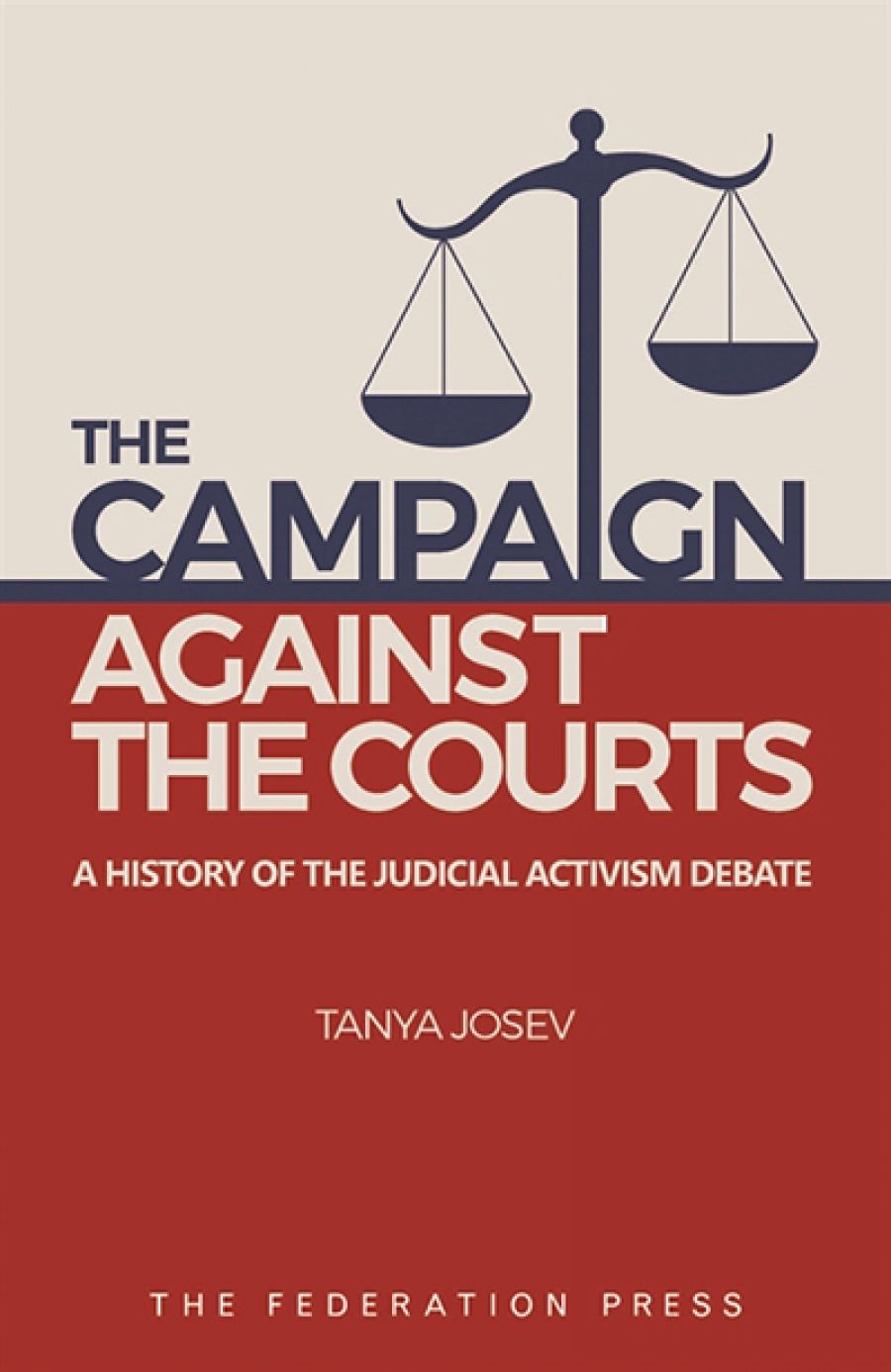
- Free Article: No
- Contents Category: Law
- Custom Article Title: John Eldridge reviews 'The Campaign against the Courts: A history of the judicial activism debate' by Tanya Josev
- Custom Highlight Text:
Although a subject of endless fascination in the hermetic world of the legal profession, the judiciary seldom excites the interest of the broader public. Despite the efforts of senior judges to promote understanding of the legal system, the community seems largely content simply to trust that the machinery of justice is working ...
- Book 1 Title: The Campaign against the Courts:
- Book 1 Subtitle: A history of the judicial activism debate
- Book 1 Biblio: Federation Press, $49.95 pb, 256 pp, 9781760021436
When such debates are afoot, few accusations are levelled as freely as the suggestion that the impugned judges have engaged in ‘judicial activism’. It is with the origins and evolution of this epithet that Tanya Josev is concerned in this impeccably researched and eminently topical book. As Josev reveals, the ‘judicial activist’ label first appeared in a 1947 Fortune column by the historian Arthur Schlesinger Jr, who employed it as a relatively innocuous shorthand when categorising the judicial attitudes of the then members of the United States Supreme Court. With close attention to US political and jurisprudential developments, Josev traces the way in which the term came to have its powerfully pejorative connotation.
In turning to the domestic arrival of the judicial activism debate, Josev engages in a careful sketch of the intellectual history of the High Court of Australia. Josev begins with a consideration of the High Court in the time of Australia’s most venerated jurist, Sir Owen Dixon, who famously espoused a ‘strict and complete legalism’ in judicial decision-making. Previous writings on the legacy of Sir Owen Dixon have not always been characterised by moderation of sentiment or temperance of tone, with some commentators seemingly wishing to best each other’s efforts at hagiographic adulation. Josev’s exploration of Dixon and his judicial philosophy – which includes a careful consideration of the meaning of ‘legalism’ and the cultural influence the term has had – is a welcome antidote to this earlier body of writing. Josev then turns to more recent history, examining the evolution in the High Court’s jurisprudence under Chief Justices Sir Anthony Mason and Sir Gerard Brennan. It is in this period that the some of the most politically charged decisions in recent memory – such as the famous judgments in Mabo and Wik – were handed down, and the commentary sparked by these decisions provides much grist for an exploration of the public’s attitude to the courts.
Josev’s analysis affords a number of important insights. Perhaps the most striking is that the ‘judicial activist’ label is applied with a maddening lack of consistency, and is often brought to bear in the course of intellectually lazy criticisms, which centre on the acute circumspection said to be owed by ‘unelected’ judges. Yet equally noteworthy – especially in light of the recent populist resurgence – is Josev’s consideration of judicial activism as a species of ‘élitism’.
There are perhaps only two criticisms which can be made of this work. The first relates to Josev’s heavy reliance on the United States as a source of comparative material. Given its role in originating the ‘judicial activist’ label, this tendency is readily explicable. Yet there are many lessons which might be learned from an examination of other jurisdictions. A consideration of recent developments in the United Kingdom might have been especially fruitful given the febrile commentary which has surrounded the litigation sparked by Brexit. Indeed, much of that commentary has explicitly employed the language of ‘judicial activism’, with former Conservative Party leader Iain Duncan Smith writing in the Telegraph in November 2016 under a headline declaiming ‘Judicial Activism and the Threat of Constitutional Crisis’. Recent events in Britain might also have aided Josev’s analysis of judicial activism as a species of élitism, with the Daily Mail branding judges ‘Enemies of The People’ for rendering decisions which hindered the government’s Brexit agenda. Although Josev adverts in passing to these developments, one is left wishing that more space had been devoted to a consideration of what significance the British developments may have for Australia.
 Owen Dixon, 1950 (National Library of Australia)
Owen Dixon, 1950 (National Library of Australia)
The second reservation relates to the book’s scope. By focusing on the origins and evolution of a particular appellation, Josev has at times run the risk of losing sight of the substantive debate – relating to the proper limits and function of the judiciary – in which it is a rhetorical tool. The public’s interest in this debate plainly pre-dates the rise of the ‘judicial activism’ label, and it might have been interesting to examine some of those earlier public debates to see how the participants characterised judges to whom the label would today almost certainly be applied. To give just one example, one might look to Sir Henry McCardie, an early-twentieth-century English judge whose colourful pronouncements on all manner of controversial social questions made him a subject of popular fascination and debate.
Of course, to cavil in these two respects with Josev’s approach is not to deny the significant contribution which this work makes to an understanding of the history of the judicial activism debate. In combining a masterful understanding of law and jurisprudence with a formidable marshalling of a mass of illuminating primary material, Josev has shed new light on the relationship between judges and the public which they serve.


Comments powered by CComment